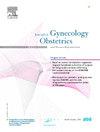Comparison of obstetric outcomes between single and double embryo transfers among singleton live births from vitrified donor oocyte IVF cycles: a cohort study
IF 1.6
4区 医学
Q3 OBSTETRICS & GYNECOLOGY
Journal of gynecology obstetrics and human reproduction
Pub Date : 2025-09-09
DOI:10.1016/j.jogoh.2025.103020
引用次数: 0
Abstract
Research objective
Among singleton live births resulting from donor oocyte cycles, do perinatal outcomes differ between single (SET) and double embryo transfers (DET)?
Methods
We utilized a retrospective cohort of 610 recipients who had a singleton livebirth following nonidentified vitrified donor oocyte IVF cycle from a fertility clinic in the southeast US, 2008–2016. Perinatal outcomes included gestational age and birth weight. Preterm birth was defined as <37 weeks and low birth weight was defined as <2500 grams. Cluster weighted generalized estimating equations were used to calculate effect estimates adjusted for year, embryo stage, prior donor transfers, recipient and donor age, recipient and donor body mass index, and infertility diagnosis.
Results
Among the 698 singleton live births, 482 (69 %) were the result of a SET while 216 (31 %) were the result of a DET. Women who had two embryos transferred, as compared with one, did not have a statistically significant difference in gestational age (adjusted mean difference [AMD]:0.23 weeks, 95 % confidence interval [CI]:0.63, 0.17) or birth weight (AMD:27.9 grams, 95 % CI:137.7, 81.9). Similar, non-significant results were observed when evaluating risk of preterm birth and low birthweight.
Conclusion
We did not observe an adverse impact of DET on gestational age or birthweight compared to SET in singleton live births from donor cycles. While reassuring, clinicians should continue to use SET in donor oocyte recipients to reduce the adverse impact of multiple pregnancy and all the associated adverse birth outcomes.
玻璃化供体卵母细胞体外受精周期中单胎和双胎移植的产科结局比较:一项队列研究。
研究目的:在供体卵母细胞周期导致的单胎活产中,单胎移植(SET)和双胎移植(DET)的围产期结局不同吗?方法:我们采用了一项回顾性队列研究,来自美国东南部一家生育诊所,2008-2016年,在未识别的玻璃化供体卵母细胞体外受精周期后,有610名单胎活产的受者。围产期结局包括胎龄和出生体重。早产定义为:结果:在698例单胎活产中,482例(69%)是SET的结果,216例(31%)是DET的结果。移植了两个胚胎的妇女与移植了一个胚胎的妇女相比,在胎龄(调整平均差[AMD]:0.23周,95%可信区间[CI]:0.63, 0.17)或出生体重(AMD:27.9克,95%可信区间[CI]: 137.7, 81.9)方面没有统计学上的显著差异。同样,在评估早产和低出生体重的风险时,也观察到无显著结果。结论:与SET相比,我们没有观察到DET对供体周期单胎活产的胎龄或出生体重的不利影响。虽然可以放心,但临床医生应该继续在供体卵母细胞受体中使用SET,以减少多胎妊娠的不良影响和所有相关的不良分娩结局。
本文章由计算机程序翻译,如有差异,请以英文原文为准。
求助全文
约1分钟内获得全文
求助全文
来源期刊

Journal of gynecology obstetrics and human reproduction
Medicine-Obstetrics and Gynecology
CiteScore
3.70
自引率
5.30%
发文量
210
审稿时长
31 days
期刊介绍:
Formerly known as Journal de Gynécologie Obstétrique et Biologie de la Reproduction, Journal of Gynecology Obstetrics and Human Reproduction is the official Academic publication of the French College of Obstetricians and Gynecologists (Collège National des Gynécologues et Obstétriciens Français / CNGOF).
J Gynecol Obstet Hum Reprod publishes monthly, in English, research papers and techniques in the fields of Gynecology, Obstetrics, Neonatology and Human Reproduction: (guest) editorials, original articles, reviews, updates, technical notes, case reports, letters to the editor and guidelines.
Original works include clinical or laboratory investigations and clinical or equipment reports. Reviews include narrative reviews, systematic reviews and meta-analyses.
 求助内容:
求助内容: 应助结果提醒方式:
应助结果提醒方式:


